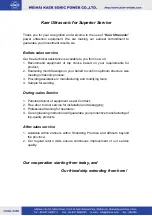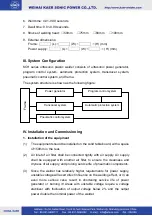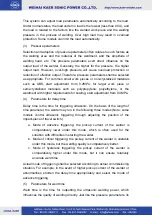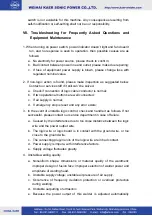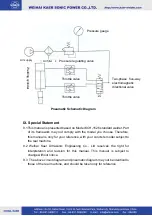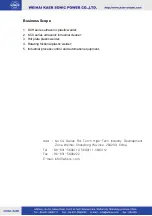
(4) Before operating the welder, make sure to connect the ground wire
properly, with ground resistance less than 0.5ohm.
Never operate the welder without proper grounding!
(5)
Before switching on, please make sure that proper power supply and air
supply are used, the cable wires have been connected correctly, the limit
of welding head has been well set, and the hands and other parts are at
safe operation position.
(6) Rotate the limit screw below the welding head support, adjust the
cylinder stroke (adjusting air pressure to zero and pulling the welding
head support up and down with a hand to observe the stroke), for
facilitating the work piece to enter and exit the tooling.
(7)
Unfasten the locking wrench adjacent to the post, adjust the height of the
welder according to the heights of the tooling and the work piece, and fix
it tightly (this function is not available to some models.)
(8)
Calibrate the positions of welding head, work piece and tooling: If the
bottom surface of the welding head isn’t fit closely with the upper surface
of the work piece, adjust the screw for leveling the welding head off, or
adjust the tooling by means of padding with paper, and finally, lock them.
(9)
Adjust air pressure to 0.14MPa, press the pneumatic testing button, or
press the operation button in the mode of manual gear, and the welding
head will descend. Re-check the positions of welding head, work piece
and
tooling, and if there’s no problem, adjust the limit screw finely and
appropriately according to the depth of fusion, and lock it. The welding
head will rise to its original position by pressing the pneumatic testing
buttons like emergency stop or reset button.
2. Commissioning the operational parameters
(1)
Parameters of working frequency
The power generator of this ultrasonic welder can track the working frequency
of the transducer automatically within certain range of working frequency (i.e.
working frequency band). However, influenced by external factors, changes of
the transducer’s natural frequency may exceed the generator’s working
frequency band, which may lead to the fault of frequency deviation. Operating
the welder under the status of frequency deviation will cause poor welding
quality, or more seriously damage the ultrasonic power generator or
transducer system. Therefore, in the event of frequency deviation, make sure


